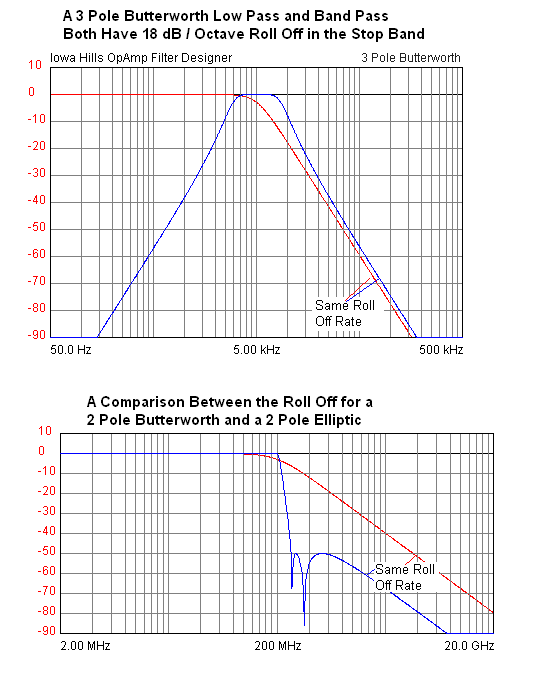I have noticed that some manufacturers of audio processing products label a 2nd order Butterworth low pass as having a slope of 12dB per octave, but then also label a 2nd order Butterworth band pass as having a slope of 12dB per octave. In actuality each side of a 2nd order Butterworth band pass has a slope of only 6dB per octave. Is there a convention that because it is symmetrical that the slope of each together constitute the "slope" or is it just that they are wrongly assuming that order is equivalent to slope for all the Butterworth filter types?
1 Answer
By convention, the pole count refers to the number of poles in the design polynomial (Butterworth, Chebyshev, etc) and this defines the amount of roll off in the stop band.
If we maintain this convention, then all filters roll off at the rate of 6 dB / octave / pole in the stop band, whether it is a low pass, high pass, band pass, or notch.
Also, a nth order Elliptic has the same ultimate roll off rate in the stop band as a nth order Butterworth. Of course, the Elliptic's transition band will be much narrower.
-
$\begingroup$ There's just one problem with your answer: your band pass has 6 poles not 3 (it has 3 zeros). It's impossible to create a conventional Butterworth band pass with an odd order as the way to create a band pass is by using the low pass to band pass transform which doubles the order (the symmetry is another giveaway that means it must be an even order). $\endgroup$– keithCommented Apr 15, 2016 at 6:19
-
$\begingroup$ If you are implying the prototype low pass that the band pass is derived from has 3 poles, then that's fine, but in my question I mean the order of the filter is the number of poles in the final filter, not the prototype, i.e. consider the RJB cookbook filters and compare a second order band pass to a second order low pass. $\endgroup$– keithCommented Apr 15, 2016 at 6:27
-
$\begingroup$ I realize that the bandpass filter I plotted has a 6th degree transfer function, and the elliptic low pass filter I plotted has an 8th degree transfer function. I gave my answer based on what I believe is the terminology used in industry. As I said, the filter's pole count will always tell you the roll off rate in the stop band. 6 dB / pole / octave. $\endgroup$ Commented Apr 15, 2016 at 14:50
-
$\begingroup$ Thanks, I am confused! What is the difference between the filter's pole count and the transfer function's pole count? My simple maths view of it is that 6th degree transfer function must have a 6th degree polynomial in the numerator or denominator (or both) which by definition has 6 roots (a.k.a. poles given the polynomial for the band pass in question is in the denominator). By "filter" do you mean "prototype low pass filter"? $\endgroup$– keithCommented Apr 15, 2016 at 15:21
-
$\begingroup$ When I speak of pole count, I am referring to the order of the low pass prototype, not the order of the filter's transfer function. Then the terminology is always consistent. All filters (low pass, bandpass, etc) roll off at 6 dB / octave / pole. And this agrees with the manufacturers specs you quoted in your question. In RF filter design, a 3 pole bandpass filter will typically have 11 or more reactive elements, but they certainly don't give an 11 pole response, or a 5.5 pole response. $\endgroup$ Commented Apr 15, 2016 at 15:48

